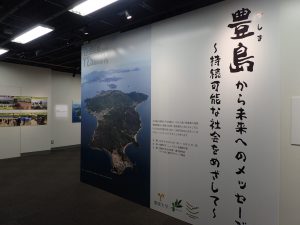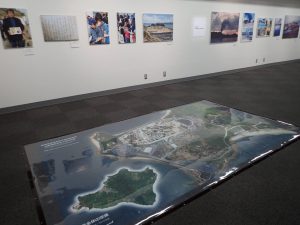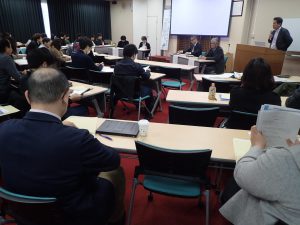豊島(てしま)展・記念シンポジウム~ごみ問題に向き合う/Teshima Exhibition • Memorial Symposium – Facing the garbage problem/丰岛(Teshima)展・纪念研讨会~垃圾问题的抗争
瀬戸内海の豊島(香川県)における産業廃棄物不法投棄事件をご存知でしょうか。1975年に業者による有害産業廃棄物処分場の許可申請に端を発し、住民による反対運動、取締りの要請にもかかわらず、不法投棄が1990年まで続けられました。住民・市民は中坊公平氏ら弁護団の支援を得て廃棄物の撤去を求める運動を展開し、ようやく2000年に香川県との公害調停が成立。2003年から廃棄物の撤去と直島での無害化処理が開始されました。そして、2017年3月に最後の廃棄物搬出船が豊島を出航し、42年にわたって続いた住民と市民の活動は区切りを迎えました。

<愛媛大学ミュージアムで開催の豊島展>
日本最大規模と言われた不法投棄と向き合った豊島の経験をこれからの社会に活かそうと、その過程を写真パネル等で振り返る「豊島展」がNPO法人瀬戸内オリーブ基金(以下、オリーブ基金)によって開催されています。オリーブ基金はこの展示を通して、「都市部で発生した大量のごみが不法投棄によって抵抗力の弱い過疎の島に流入し、住民が死にものぐるいの声をあげなくてはならなくなったこと」「破壊された自然を回復するためには莫大な費用と手間がかかること」「大量廃棄の社会から資源循環型社会・持続可能な社会への転換を考えなくてはならないこと」を伝えたいとのメッセージを掲げています。

<展示の様子>
「豊島展」は2017年7月に高松市、同11月に東京都豊島区において行われ、本年10月24日~12月17日には愛媛大学法文学部兼平研究室が主催に加わり、愛媛大学ミュージアム企画展示室にて開催されています。11月24日には、同展の開催を記念してシンポジウム「豊かな島と海を次の世代へ」が開催され、豊島事件を振り返るとともに、マイクロプラスチックに関する世界の取組と研究の報告、パネルディスカッションがありました。
「マイクロプラスチックも豊島の問題も、ごみが自分の目の前から無くなりさえすれば問題にしないという、これまでの消費者の姿勢が生み出したもの。一人ひとりが自分事としてごみの問題に向き合うきっかけにしていただきたい」と、オリーブ基金の担当者がシンポジウムへの期待を話されていました。

<豊島展記念シンポジウムの様子>
マイクロプラスチックの存在と環境への影響が発信されるようになり、ごみ問題は待ったなしで向き合うべき課題との認識が高まっています。海ごみについては世界的な規模は計り知れず、発生の抑制と存在するごみの除去を果てしなく継続する必要があります。が、豊島事件に向き合ってきた市民が解決の道を切り開いてきたように、「決してあきらめず、多様な関係者が協働して対応を進めていくことが大切」という思いを強くすることができました。豊島の知見を踏まえ、愛媛大学などの最新の研究を学びながら、海に囲まれ、海の恩恵を受けて来た四国から、取組が発信できるよう、活動と連携を発展させていきましょう。
豊島産廃問題については、オリーブ基金が制作した専用サイトをご参照ください。
豊島・島の学校「豊かな島と海を次の世代へ」
http://www.teshima-school.jp
■Teshima Exhibition • Memorial Symposium – Facing the garbage problem
Do you know about the illegal dumping of industrial waste at Teshima (Kagawa Prefecture) into the Seto Inland Sea? Irregular dumping continued until 1990, despite requests from hospitals about hazardous industrial waste in 1975, as well as an opposition campaign and crackdown by residents. Residents and citizens developed an exercise calling for removal of waste with the support of Mr. Kohei Nakabo’s defense team and finally concluded mediation of pollution with Kagawa Prefecture in 2000. Removal and treatment for detoxification in Naoshima began in 2003. And in March 2017 the last waste shipping departed Teshima, the activities of residents and citizens who continued for 42 years came to a break.
<Teshima exhibition held at Ehime University museum>
The Teshima Exhibition, which looks back on the process at the photo panel etc., to utilize the experiences of Teshima facing illegal dumping, which is said to be the largest scale in Japan, in future society is held by the Setouchi Olive Fund (hereinafter referred to as the Olive Foundation). Through this exhibition, the Olive Foundation stated that “a large amount of garbage generated in urban areas has flowed into a depopulated island with weak resistance due to illegal dumping, and the residents have to give a deadly voice. It takes a huge cost and time to restore the destroyed nature. We want to tell from the society of mass disposal to a resource recycling society / a sustainable society.”
<State of exhibition>
”Teshima Exhibition” was held in Takamatsu City in July 2017 and Toshima Ward in Tokyo in November, and from October 24 to December 17, 2018, Ehime University Law and Literature Department participated in the sponsorship, and it was held at the Ehime University’s Museum Planning Exhibition Room. On November 24th, in honor of the exhibition, a symposium “Rich Island and Ocean to the Next Generation” was held to celebrate the exhibition. In addition to reviewing the Toyoshima incident, there was a panel discussion about the world efforts and research reports on microplastic.
Olive Fund staff in charge spoke about expectations for the symposium. “The issue of micro plastics and Toshima also was created by the attitude of consumers that, as long as the garbage disappears in front one’s eyes, it is not their problem but making each opportunity to face garbage problems as yourself.”
<State of Teshima Exhibition Commemorative Symposium>
The existence of microplastic and the influence on the environment are transmitted, and the recognition of the garbage problem as a matter to be confronted without waiting is increasing. Regarding marine garbage, the scale of the world is immeasurable, and it is necessary to continue the endless control of occurrence and removal of existing garbage. However, as citizens who have been facing the Toshima Incident have opened up the road of solution, it is important to strengthen the thought that “it is important not to never give up, to collaborate and deal with various stakeholders.” Based on the findings of Toshima, it is hoped that activities and cooperation with Ehime University can happen so that efforts can be disseminated from Shikoku, which is surrounded by the sea and that people receive many benefits from.
For Teshima industrial waste disposal, please refer to the dedicated site created by the Olive Foundation.
School of Teshima • Island “To a rich island and ocean to the next generation”
http://www.teshima-school.jp
■丰岛(Teshima)展・纪念研讨会~垃圾问题的抗争
您知道发生在濑户内海的丰岛(香川县)的产业废弃物非法投弃事件吗?1975年,发端于工厂方申请有害产业废弃物处理场的许可,尽管居民开展反对运动,要求停止,但非法投弃却持续到了1990年。居民・市民得到了中坊公平等律师团的支持,展开了清除废弃物的活动,终于在2000年使得香川县立案了公害调停。从2003年起,废弃物清除和直岛的无害化处理开始了。之后,2017年3月,最后一艘废弃物搬出船从丰岛出航,居民与市民历经42年坚持的活动终于迎来了句号。
<举办于爱媛大学博物馆的丰岛展>
为了将曾与被称为日本最大规模的非法投弃抗争的丰岛经验发挥到今后的社会中,NPO法人濑户内橄榄基金(下称橄榄基金)举办了将其历程以照片形式呈现回顾的“丰岛展”。橄榄基金想要通过本展览,传达“将都市产生的大量垃圾非法投弃,流入抵抗力脆弱的人口密度低的岛上,居民不得不竭尽全力地发出声音”“要让被破坏的大自然恢复,需要耗费极大的金钱和精力”“大量废弃的社会转型为资源循环型・可持续社会迫在眉睫”的信息。
<展览概况>
“丰岛展”于2017年7月在高松市举办,后又在同年11月于东京都丰岛区举办,今年由爱媛大学法文学部兼平研究室主办,在10月24日-12月17日期间于爱媛大学博物馆企划展示室开展了。11月24日,为纪念该展览开展,举办了“丰富的岛与海,传给下一代”的研讨会,既回顾了丰岛事件,同时还进行了关于微塑料的世界性对策和研究的报告和专题讨论。
“微塑料也事,丰岛问题也事,我们都可以看到至今为止的消费者的态度是,垃圾只要从自己的面前消失掉就没问题了。希望每一个人都能以此为契机,将垃圾问题作为自己的事情解决。”橄榄基金的负责人说,寄托了对研讨会的期待。
<丰岛展纪念研讨会概况>
微塑料的存在和对环境的影响已经被传达出去,人们提高了认识:垃圾问题是一个刻不容缓必须解决的课题。关于海洋垃圾,世界性规模难以计算,必须抑制其产生,并且继续坚持不懈地消除已存在的垃圾。丰岛事件中抗争奋斗的市民所劈开的解决之道所揭示的“重要的是绝不放弃,各种各样的相关者共同合作起来,前进解决”思想被强化了。立足于丰岛的知识经验,在海洋环绕、饱受海洋恩惠的四国,让我们一边学习爱媛大学最新的研究,一边将人们的努力传达出去,共同合作,发展活动吧。
关于丰岛产废问题,请参照橄榄基金制作的专门网站。
丰岛・岛之学校“丰富的岛与海,传给下一代”
http://www.teshima-school.jp



